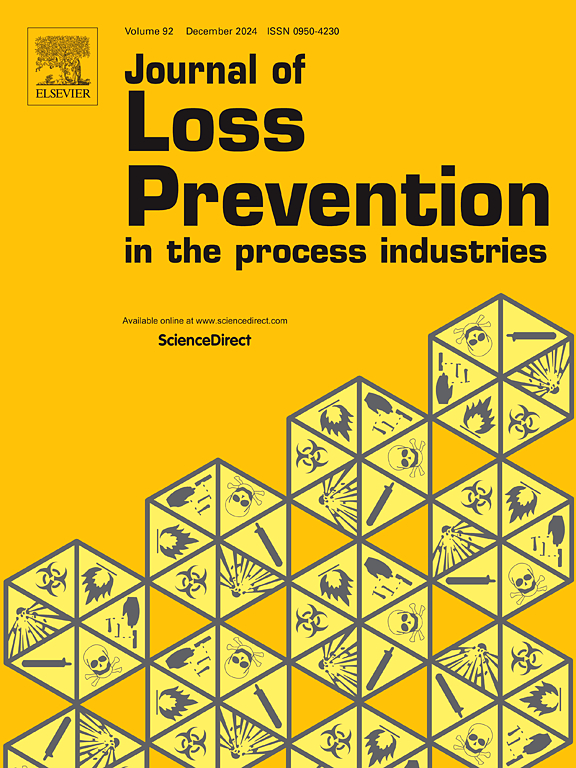The effect of fuel concentration on intrinsic flame instabilities and flame acceleration in lean H2-CO-air mixtures
IF 3.6
3区 工程技术
Q2 ENGINEERING, CHEMICAL
Journal of Loss Prevention in The Process Industries
Pub Date : 2025-03-25
DOI:10.1016/j.jlp.2025.105643
引用次数: 0
Abstract
In large scale accident scenarios of nuclear power plants core meltdown and molten-core-concrete-interaction can occur. Large amounts of syngas mainly consisting of hydrogen (H2) and carbon monoxide (CO) might be formed and mixed with the surrounding air, developing a potentially explosive mixture. The ignition of the flammable mixture might lead to flame acceleration and in worst cases to the destruction of the reactor building, causing the detachment of radioactive substances to the environment. To prevent future accidents, the understanding of flame accelerating conditions of syngas-air mixtures, in specific the understanding of the flame topology, must be improved. To the authors’ knowledge, insufficient data on flame topology investigating ignition and early stages of flame propagation in lean H2-CO-air mixtures is available. Therefore, in this study experiments are carried out to analyze the ignition and slow deflagration of a 50/50 H2/CO fuel mixture with fuel-to-air concentrations between 13.0 vol.-% - 29.5 vol.-%. A model calculating the flame acceleration in early stages of flame propagation is suggested. The GraVent explosion channel located at Technical University of Munich is used for the experiments in this study in its configuration of 1300 mm in length and a rectangular cross section of 300 × 60 mm. OH-PLIF measurements are used to determine flame front speed, flame acceleration and flame front length. Wrinkling factors are determined by the division of the wrinkled flame front length caused by intrinsic flame front instabilities and the smooth flame front length to quantify the influence of intrinsic flame front instabilities on early stages of flame acceleration. The optical experimental data contains the ignition of the gas mixtures as well as early stages of flame propagation. In conclusion, the results gathered in this study provide information on the topology of H2-CO-air flames under lean conditions enhancing the understanding of syngas flame acceleration and extending experimental data provided in former studies with relevance to large scale accident scenarios of nuclear power plants.
燃料浓度对稀薄h2 - co -空气混合物内在火焰不稳定性和火焰加速的影响
在核电站的大规模事故场景中,可能会发生堆芯熔毁和熔融体-堆芯-混凝土相互作用。大量的主要由氢(H2)和一氧化碳(CO)组成的合成气可能会形成,并与周围的空气混合,形成潜在的爆炸性混合物。可燃混合物的点火可能会导致火焰加速,在最坏的情况下会破坏反应堆建筑物,导致放射性物质向环境中分离。为了防止未来发生事故,必须提高对合成气-空气混合物火焰加速条件的认识,特别是对火焰拓扑结构的认识。据作者所知,在稀薄的h2 - co -空气混合物中,火焰拓扑研究点火和火焰传播早期阶段的数据不足。因此,在本研究中,进行了实验来分析50/50的H2/CO燃料混合物的点火和慢爆燃,燃料对空气的浓度在13.0 vol.-% - 29.5 vol.-%之间。提出了一种计算火焰传播初期火焰加速度的模型。本研究采用位于慕尼黑工业大学的GraVent爆炸通道进行实验,其长度为1300mm,矩形截面为300 × 60mm。OH-PLIF测量用于确定火焰前速度,火焰加速度和火焰前长度。通过划分由内在火焰锋面不稳定引起的起皱火焰锋面长度和光滑火焰锋面长度来确定起皱因子,量化内在火焰锋面不稳定对火焰加速早期阶段的影响。光学实验数据包含了混合气体的点火和火焰传播的早期阶段。总之,本研究的结果提供了稀薄条件下h2 - co -空气火焰的拓扑信息,增强了对合成气火焰加速的理解,并将以往研究提供的实验数据扩展到与核电站大规模事故场景相关的研究中。
本文章由计算机程序翻译,如有差异,请以英文原文为准。
求助全文
约1分钟内获得全文
求助全文
来源期刊
CiteScore
7.20
自引率
14.30%
发文量
226
审稿时长
52 days
期刊介绍:
The broad scope of the journal is process safety. Process safety is defined as the prevention and mitigation of process-related injuries and damage arising from process incidents involving fire, explosion and toxic release. Such undesired events occur in the process industries during the use, storage, manufacture, handling, and transportation of highly hazardous chemicals.

 求助内容:
求助内容: 应助结果提醒方式:
应助结果提醒方式:


